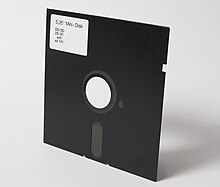

This article needs additional citations for verification. Please help improve this articlebyadding citations to reliable sources. Unsourced material may be challenged and removed.
Find sources: "Disk density" – news · newspapers · books · scholar · JSTOR (May 2023) (Learn how and when to remove this message) |

Disk density is a capacity designation on magnetic storage, usually floppy disks. Each designation describes a set of characteristics that can affect the areal density of a disk or the efficiency of the encoded data. Such characteristics include modulation method, track width, coercivity, and magnetic field direction.
Single density (SD or 1D) describes the first generation of floppy disks that use an iron oxide coating. Floppy drives utilize 300-oersted write heads, FM encoding, and a track width of 0.330 mm (0.0130 in) for a density of 48 tracks-per-inch (tpi) and 5,876 bits-per-inch (bpi).
Double density (DD or 2D) doubles capacity over SD by replacing FM encoding with an improved line code, such as modified frequency modulation (MFM), modified modified frequency modulation (M²FM), FM/MFM or group coded recording (GCR).
SD (1D) and DD (2D) designations were generally identical to those of 8-inch disks.
Quad density (QD or 4D) doubles capacity over DD by narrowing the width of tracks to 0.160 mm (0.0063 in) for a density of 96 tpi. Some manufacturers (Micropolis, Tandon, Micro Peripherals (MPI), Teac) used a track density of 100 tpi for quad-density drives, which were incompatible with 96 tpi models.
The Commodore 8050 and 8250 are rare instances of drives that used 375 kbit/s GCR code instead of the usual 250 kbit/s double-density format and they could store roughly 500 kilobytes on one side of a disk.
High density (HD) improves capacity by utilizing a 96 tpi track density in conjunction with improved cobalt disk coating and stronger 600-oersted write heads, allowing 9,646 bpi to be written.
Double density (DD) 3½-inch disks use an iron oxide coating, just as with 5¼-inch DD/QD disks. However, drives utilize stronger 670-oersted write heads and a narrower track width of 0.115 mm (0.0045 in) for a density of 135 tpi and 8,717 bpi.
High density (HD) 3½-inch disks switch to a cobalt disk coating, just as with 5¼-inch HD disks. Drives use 700-oersted write heads for a density of 17,434 bpi.
Extra-high density (ED) doubles the capacity over HD by using a barium ferrite coating and a special write head that allows the use of perpendicular recording.[1][2]
Triple density (TD) triples the capacity over ED by tripling the track density and improving other parameters.[3][4][5] The drives used longitudinal recording.[2]
| Size | 8-inch | 5¼-inch | 3½-inch | ||||||||
|---|---|---|---|---|---|---|---|---|---|---|---|
| Density | SD | DD | SD | DD | QD | HD | DD | HD | ED[1] | TD[4] | |
| Disk coating | Iron oxide[1][6] | Cobalt[1][6] | ? | Iron oxide, Cobalt?[1] | Cobalt[1][6] | Barium ferrite[1] | ? | ||||
| Coercivity [Oe] | 290,[7] 300[8][1][6] | 600,[1][6] 660,[7] 670[8] | ca. 600 | 600?,[1][6] 660,[7] 670[8] | 700,[8] 720[7][1] | 750?,[1] 1060,[7] 1200 | ? | ||||
| Coating thickness [μm] | ? | ? | ? | 100,[8] 2.5,[7] 2.0-3.0[6] | ? | 55,[8] 1.3,[7] 1.0-1.5[6] | ? | 65,[8] 1.9,[7] 2.0-3.0[6] | 55,[8] 0.9,[7] 1.0-1.5[6] | ? | ? |
| Line code | FM | MFM, M²FM, FM/MFM or GCR | FM | MFM or GCR | MFM | MFM[9] | MFM or GCR | MFM | |||
| Track width [mm] | 0.330[1] | 0.160[1] | ? | 0.115[1] | ? | ||||||
| Track density [tpi] | 48[1] | 96[1] or 100 | 96[1] | 67.5[9] | 135[1] | 406.5[4] | |||||
| Bit density [bpi] | 5,876,[2][1] 5,922[10] | 9,646,[1] 9,870[2] | 8,650[9] | 8,717[2][1] | 17,432,[2] 17,434[1] | 34,868[2][1] | 36,700[4] | ||||
| Recording direction | longitudinal / horizontal[1] | perpendicular / vertical[1] | longitudinal[2] / horizontal[1] | ||||||||
[…] Hitachi-Maxell hat ein 3½-Zoll-Diskettenlaufwerk mit einer Speicherkapazität von 12.5 MB entwickelt. Nach eigenen Angaben will das Unternehmen auf OEM-Basis den Hersteller NEC mit den Geräten versorgen. Dort sollen sie als externer Speicher für die neue PC-Serie PC88VA3 eingesetzt werden. Die Laufwerke mit der Bezeichnung PC FD810.1 sind voraussichtlich ab dem vierten Quartal dieses Jahres lieferbar. Bis Ende 1989 will NEC die ersten 150000 Geräte verkauft haben. […]